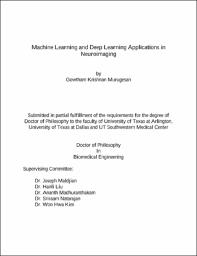
ATTENTION: The works hosted here are being migrated to a new repository that will consolidate resources, improve discoverability, and better show UTA's research impact on the global community. We will update authors as the migration progresses. Please see MavMatrix for more information.
Show simple item record
| dc.contributor.advisor | Maldjian, Joseph A | |
| dc.creator | Murugesan, Gowtham Krishnan | |
| dc.date.accessioned | 2020-09-10T17:39:30Z | |
| dc.date.available | 2020-09-10T17:39:30Z | |
| dc.date.created | 2020-08 | |
| dc.date.issued | 2020-08-20 | |
| dc.date.submitted | August 2020 | |
| dc.identifier.uri | http://hdl.handle.net/10106/29415 | |
| dc.description.abstract | Deep Learning (DL) tools have the potential to analyze large datasets and extract meaningful insights to enhance patient outcomes. Radiological images such as MRI and CT, often contain complex patterns that can be difficult and time consuming to evaluate manually. Deep learning algorithms can improve treatment decisions and patient care beyond the realm of research. The goal of this dissertation is to apply advanced deep learning methods in three distinct domains of neuroimaging, 1.fMRI Analysis, 2. MR Image Synthesis, and 3. Clinical applications in brain tumors.
First, we developed a new fMRI network inference method named as BrainNET using Machine Learning (ML). We validated the proposed model on ground truth simulation data and on the open-source “ADHD 200 preprocessed” data from Neuro Bureau. BrainNET demonstrated excellent performance across all simulations and in the ADHD dataset. Further, we applied BrainNET in an explorative study to analyze effects of subconcussive impacts in youth and high school (ages 9-18). In this study we utilized graph theory and ML data driven methods to examine functional changes in brain over a single season of American football. This study demonstrates an association between changes in functional connectivity related to head impact exposure level in youth and high school football.
Second, we developed a novel deep learning algorithm to synthesize post gadolinium contrast image using only non-contrast MR images. In this study, we used novel deep learning approaches to synthesize T1 post-contrast (T1c) gadolinium enhancement from non-contrast multi-parametric MR images (T1w, T2w, and FLAIR) in patients with primary brain tumors. Two expert neuroradiologists independently scored the synthesized post-contrast images using a 3-point scale (1, poor; 3, good; 3, excellent). The predicted T1c images demonstrated structural similarity, PSNR, and NMSE scores of 95.62 37.8357, and 0.0549, respectively. Our model was able to synthesize Gadolinium enhancement in 92.8% of the cases. Finally we developed DL algorithms to aid clinical applications of neuroimaging in segmenting brain tumors and predicting molecular status using only MR images. | |
| dc.format.mimetype | application/pdf | |
| dc.language.iso | en_US | |
| dc.subject | fMRI | |
| dc.subject | MRI | |
| dc.subject | Computer vision | |
| dc.subject | Segmentation | |
| dc.subject | Image synthesis | |
| dc.subject | Brain network inference | |
| dc.subject | IDH mutation | |
| dc.title | Machine Learning and Deep Learning Applications in Neuroimaging | |
| dc.type | Thesis | |
| dc.degree.department | Bioengineering | |
| dc.degree.name | Doctor of Philosophy in Biomedical Engineering | |
| dc.date.updated | 2020-09-10T17:39:31Z | |
| thesis.degree.department | Bioengineering | |
| thesis.degree.grantor | The University of Texas at Arlington | |
| thesis.degree.level | Doctoral | |
| thesis.degree.name | Doctor of Philosophy in Biomedical Engineering | |
| dc.type.material | text | |
| dc.creator.orcid | 0000-0002-2160-6648 | |
Files in this item
- Name:
- MURUGESAN-DISSERTATION-2020.pdf
- Size:
- 4.131Mb
- Format:
- PDF
This item appears in the following Collection(s)
Show simple item record


